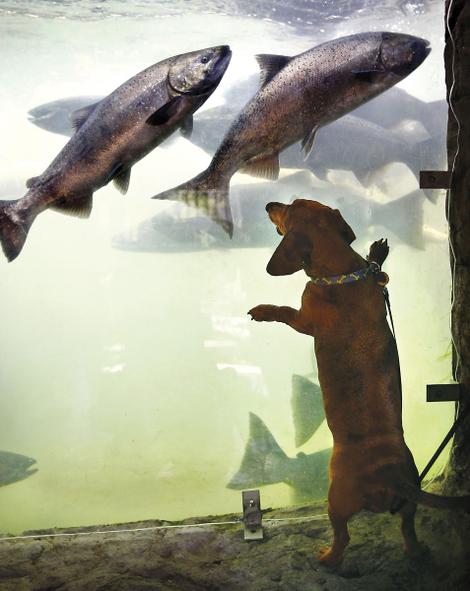forum
library
tutorial
contact

A Reunion with Old Fish
on the Snake River
by Steve Duin
The Oregonian, September 14, 2013
|
the film forum library tutorial contact |

|
A Reunion with Old Fish
by Steve Duin
|
 I don't claim to know a great deal about fish, despite the patient efforts of my father and grandfather. I no longer pretend to have much faith in politics.
I don't claim to know a great deal about fish, despite the patient efforts of my father and grandfather. I no longer pretend to have much faith in politics.
But it's long past time to toast what the Nez Perce Tribe, with a nifty assist from the late Sen. Mark Hatfield, has accomplished on the Snake River, resurrecting a glorious fall chinook salmon run.
In a memorable summer for salmon -- 63,870 chinook hit the fish ladder at Bonneville Dam on Sept. 9 -- the best recovery story may be on the Snake.
"In the 1930s, we had 500,000 Snake River fall chinook, spawning in the gravel. In 1990, it was down to 78 fish, crossing the Lower Granite Dam," notes John Platt, a lawyer who has an extensive history with the Columbia River Inter-Tribal Fish Commission.
"It's now heading to 30,000. The numbers are just amazing. And the Nez Perce did most of the work."
Added Elizabeth Furse, who served in Congress from 1993-99 and has long partnered with Platt, "I'm amazed to see a real environmental success story, and one that happened despite state and federal authorities."
As the salmon were listed as endangered species in the early '90s, the Nez Perce proposed turning the hatcheries into wild-salmon nurseries to rebuild the up-river spawning runs. When the fish were raised to fingerling size in acclimation ponds, then released into the river, the tribe believed it greatly enhanced the chinook's ability to return to the river and spawn.
Not surprisingly, the Nez Perce also believed it understood salmon better than the agencies floundering downstream.
"We had years of our elders observing these animals in their natural habitat," said Silas Whitman, the tribal chairman and the former director of its fisheries program.
"Fall chinook were a priority for the Nez Perce. We hand-reared those fish when no one else would do that. We kept their environment clean. When they were released, they were like wild fish."
Whitman was never under any illusions about how long the recovery would take.
"We feel that a short-term fix is 20 years," he said in 1992.
And he probably wasn't surprised when the National Marine Fisheries Service resisted the tribe's supplementation program. Even when the tribe won the right in federal court to restore the spawning runs on its own terms, Platt said, the feds claimed it had no money for the project.
Enter Hatfield, who, in 1996, was in his 30th and final year in the U.S. Senate and the chairman of the Senate Appropriations Committee.
Mark Walker, public affairs director for the Northwest Power and Conservation Council, was the Hatfield staffer on the Energy and Water Development subcommittee at the time.
"I remember the difficulty in getting action out of the federal agencies," Walker said. "There wasn't a biological opinion. There wasn't a recovery plan. And if you're Mark Hatfield, you're an impatient person in terms of wanting results."
So it was that Hatfield called Whitman and the Nez Perce.
"Sen. Hatfield was always attracted to the tribe's approach on things," Walker says. "They weren't scientific, genetic purists. They wanted fish recovery as quickly as possible, so their tribal members could fish again. The tribe, frankly, had a more common-sense approach on how to get the ball rolling."
When Platt once asked Hatfield when he gained such confidence in tribal priorities, the senator said it began with his mother, Dovie Odom, who taught the Siletz in Lincoln County.
Whitman told Hatfield that $5 million would go a long way toward building the acclimation ponds he needed to rebuild the Snake River fall chinook run.
Was it difficult to get that earmark through Congress?
"For Sen. Hatfield, it wasn't hard at all," Walker says. "It was classic Hatfield. He was in the right place at the right time."
Among old friends on the banks of the Snake, the Nez Perce know the feeling.
"They were more pragmatic about things," Walker says, "and their pragmatism has led to 30,000 fall chinook."
learn more on topics covered in the film
see the video
read the script
learn the songs
discussion forum
